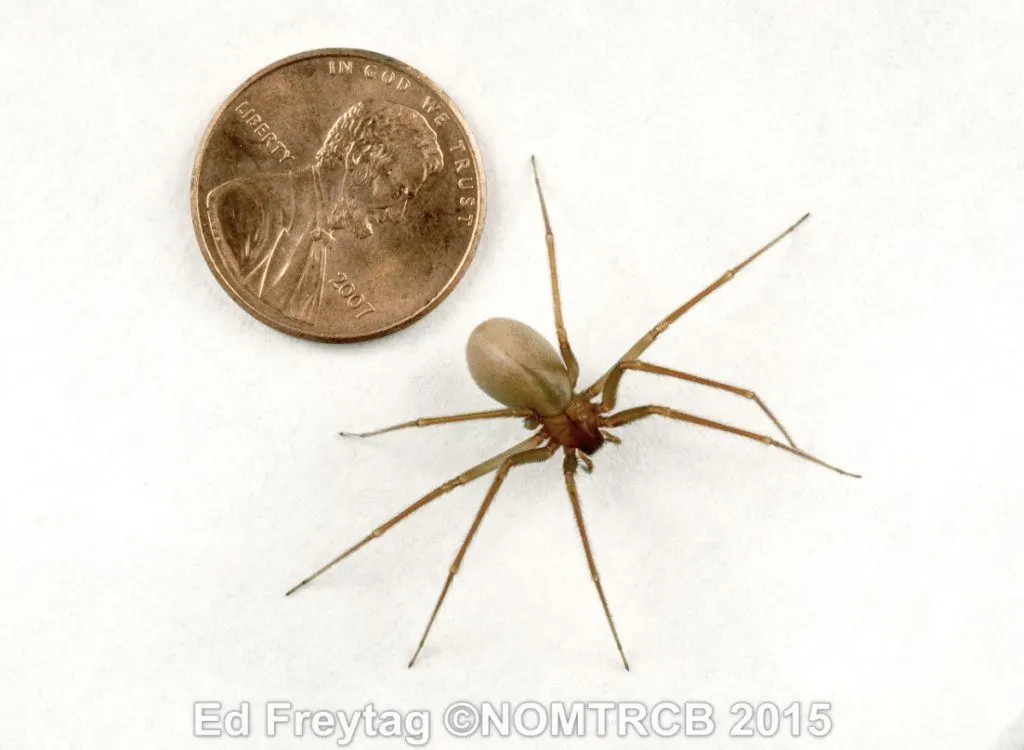
How to Get Rid of Brown Recluse Spiders
If you have an active brown recluse infestation, follow these guidelines to learn how to get rid of brown recluse spiders, and the best products for brown recluse control.
December 16th, 2023
Get Rid
Brown Recluse Spider Control Steps
1. Eliminate Favorable Conditions
Get rid of Brown Recluse spiders by first eliminating their hiding areas' favorable conditions. We listed these in the ‘Inspect’ section above.
2. Inspect and Clean
It is important to inspect, clean, and exclude as much as possible before using residual insecticides to eliminate brown recluses.
Inspect for signs of a brown recluse spider infestation and either vacuum them or spray them with a contact aerosol like CB 80 Aerosol.
3. Apply Insecticide Sprays and Dust to Get Rid of Brown Recluses
Because this species of spider is so dangerous, we do not recommend trying to kill brown recluse spiders naturally. To kill brown recluses, we suggest using a residual insecticide as a perimeter spray such as Onslaught Fastcap, Suspend Poly Zone, Demand CS, Avesta CS, and Cyper WSP.
This will remove as many insects as possible that would enter your home and serve as food sources for these spiders. You can also spray this inside on baseboards, in corners, under furniture, and in other areas where they are living.
Just spraying these residual insecticides is not enough to get rid of brown recluses, however. It needs to be accompanied by inspection, cleaning, and dusting to thoroughly kill brown recluse spiders.
We have a kit with Demand CS and PT 2llL in one kit called the Residential Spider Kit. Use the Demand CS outside (it may be sprayed inside as well), and the PT211L with its crack and crevice tip is used to spray into hiding places where the liquid can not reach.
Use dust like Cimexa Dust or D-Fense Dust. Use Cimexa Dust or D-Fense Dust in all of their hiding places discussed below, such as wall voids, light switch plates, and behind baseboards.
This insecticide dust will stay in place for six months to a year. Several handheld dusters can be used with insecticide dust.
5. Kill Brown Recluse Spiders Outside
Besides spraying the perimeter, dust in voids, openings, and cracks and crevices found on the building's exterior.
Dust any cracks and crevices with Cimexa Dust or D-Fense Dust before sealing the openings. These dusts and sprays will repel brown recluse spiders and kill them if they come in direct contact.
Read further spider control procedures outlined at: Get Rid Of Spiders
6. Monitoring with Spider Traps
For sticky traps, the Trapper LTD Insect Glue Boards will catch spiders and monitor the population. Another excellent brand of sticky traps is The Monterey Spider Trap. It will help you kill brown recluses and serve as a monitoring tool.
.How to Identify a Brown Recluse Spider
Before you learn how to get rid of Brown Recluse spiders, you'll need to learn how to identify them.
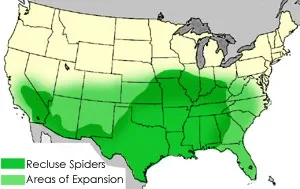
Brown Recluse Spider - Regions
With appearances similar to wolf spiders, Brown Recluse spiders can be found in the southern, western, and midwestern United States, especially Arkansas, Kansas, Illinois, Texas, Louisiana, Alabama, Kentucky, Mississippi, Oklahoma, and Missouri.
Brown recluse spiders are very adaptable and may be active in temperatures ranging from 45 to 110 degrees F.
Brown Recluse spiders are also known as, fiddleback spiders, violin spiders, and recluse spiders.
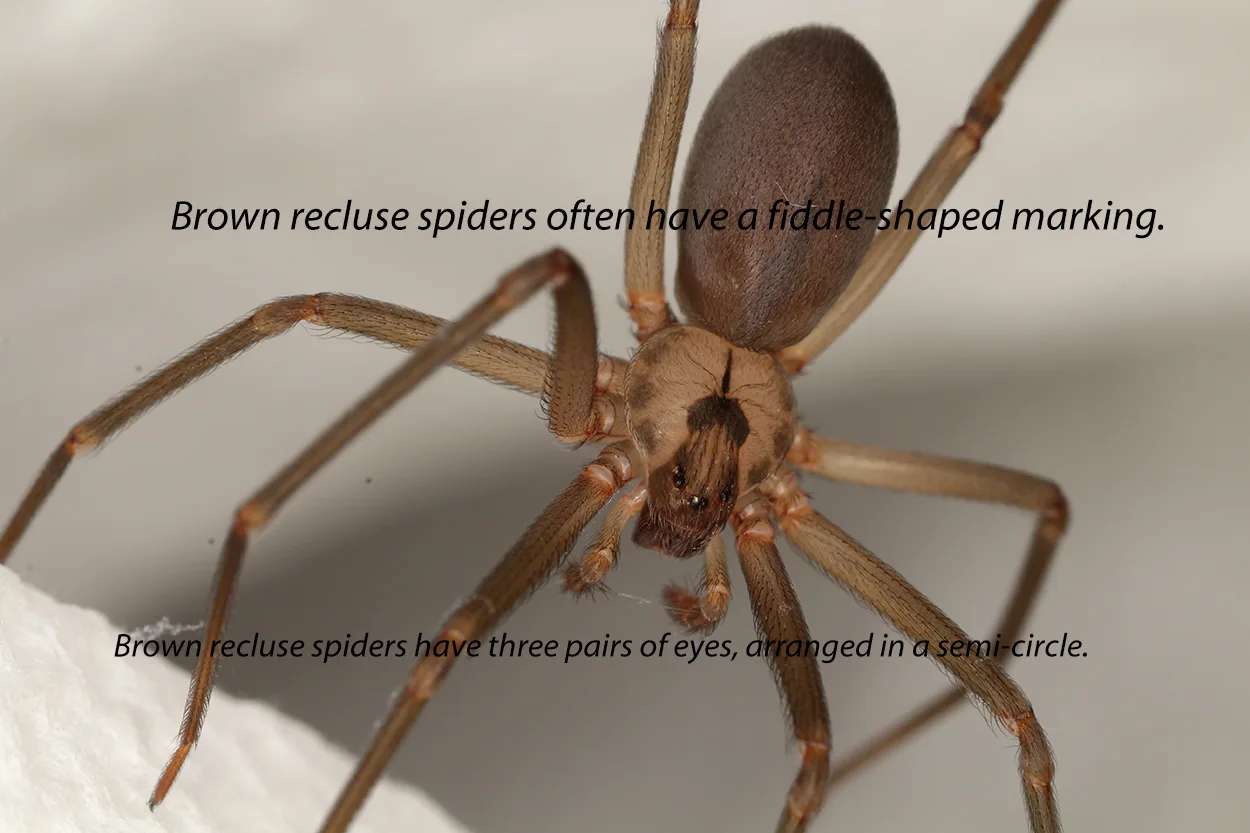
Brown Recluse Biology
To get rid of brown recluse spiders in your home, it's helpful to understand more about these creatures.
The female lays eggs in off-white silken cases from May through August. They can lay 300 eggs in their lifetime. Spiderlings emerge in 24-36 days, leaving the egg sacs with slow development (10-12 months), and are influenced by weather conditions and food availability.
Brown Recluses reach maturity in 10-12 months. These spiders can survive as long as two years without available food or water.
-
Brown recluse spider adults are soft-bodied, yellowish-tan to dark brown, and uniform-colored spiders.
-
6 eyes; most spiders have 8 eyes
-
Oval shaped abdomen
-
The adult body varies from 1/3 to 1/2 inch in length. With the legs, it can be an overall size of 1-inch diameter or greater(Body not more than 1/2").
-
No spines on legs with long thin legs that are uniformly colored.
-
If the body is a different color than the legs or the legs have different colors, it is not a Brown Recluse spider. If there is more than one color on the abdomen, it is not a Brown Recluse
-
Brown Recluse spiders have only fine hairs; if they have thick spines on their legs, they are not recluses.
-
The brown recluse spider has a distinctive dark brown violin-shaped mark, with the neck of the violin pointing towards the abdomen.
-
The tail end has no markings.
-
They are sometimes mistaken for wolf spiders, but differ because of their distinctive violin-shaped mark.
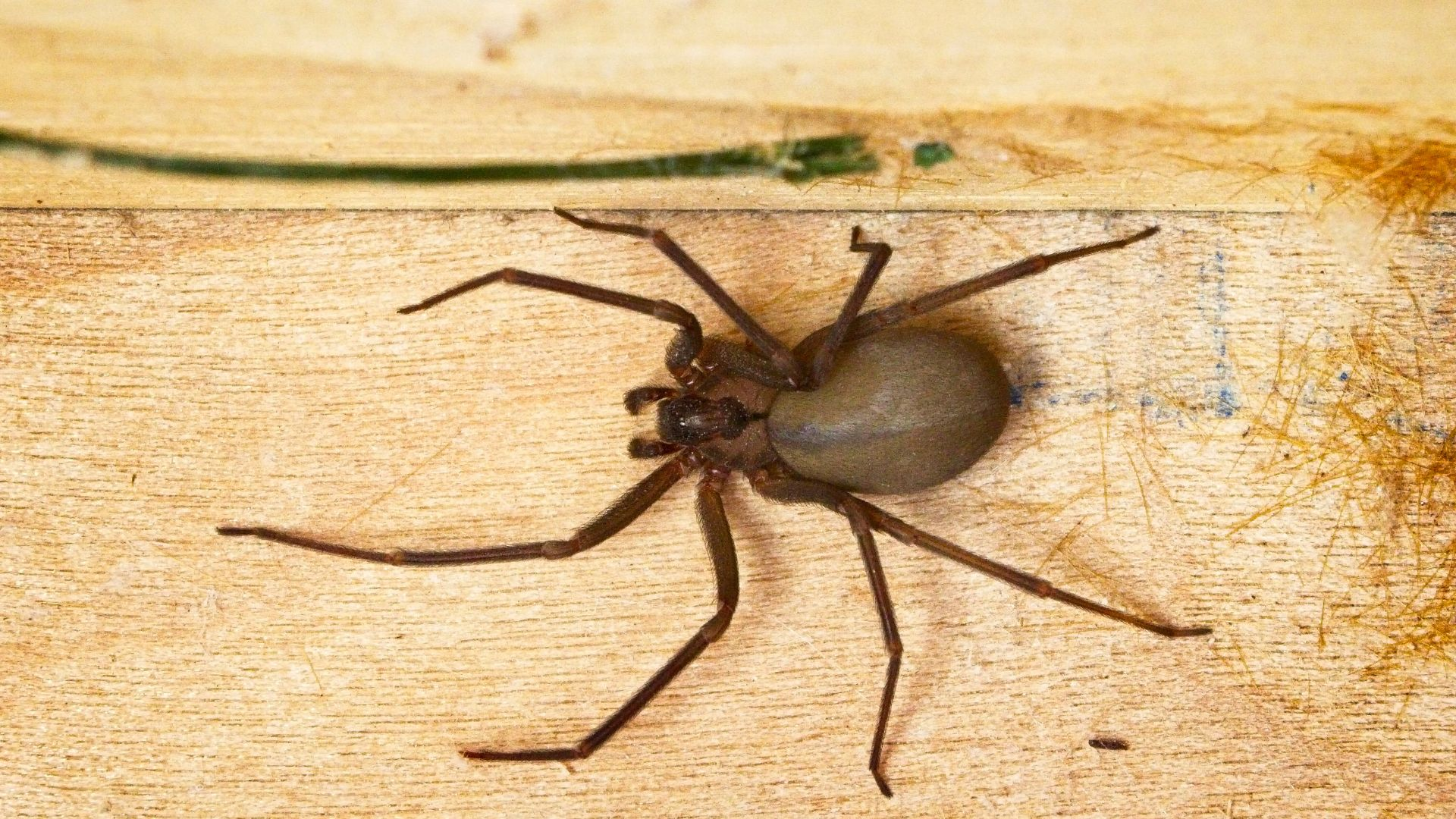
Inspection and Exclusion of Brown Recluse Spiders
To successfully get rid of brown recluse spiders and prevent them from returning, you need to know where to look. Below we have listed our top tips for inspecting your home and garden for signs of a brown recluse infestation:
-
Make sure to wear long sleeves and gloves during the inspection.
-
Always wear long sleeves, shirts, and gloves when you inspect for Brown Recluse Spiders. Since they stay in recessed and hidden areas, use a flashlight.
-
They may be found in cluttered basements or closets. Brown recluse spiders live in dark recesses, inhabiting stored clothing, old shoes, toys, books, boxes, furniture, stored linens, undisturbed towels, sheds, etc.
-
They can take shelter under furniture, appliances, carpets, behind baseboards and door facings, or in corners and crevices.
-
Look for cobwebs, particularly around clutter, under insulation, and inside wall voids. Their webs are irregular and loose and only used during the day for holding eggs. Their webs are hidden and used for retreats.
-
It is made of silk spun in a recessed or hidden area, such as behind a mirror or wall void. They do not have their webs in open areas. The Brown Recluse is a hunting type of spider and not a web-hanging spider.
-
They don't use webs for hunting and capturing food. These spiders wander at night and hunt for their prey. Their diet consists of other insects such as cockroaches and small insects. Many times, if you see a web hung on a ceiling, along walls, around shrubs, etc., they belong to another type of spider.
How to Prevent Brown Recluse Spider Infestations
1. Eliminate outside locations for brown recluse spiders
Brown recluses may be found in storage houses or buildings where items are stored. You will likely find them in sheltered corners among the debris, woodpiles, piles of rocks, logs, debris, leaves, and under loose bark or stones.
2. Inspect and clean inside locations for brown recluse spiders
Inside the home, brown recluses are usually found indoors, in bathrooms, bedrooms, closets, garages, basements, and cellars.
Brown Recluse spiders may be found in forced hot air heating, air conditioning, and often above-ceiling ductwork. They can be found harboring in or around the ductwork or registers.
3. Seal Cracks and Crevices
As much as possible, seal openings, cracks, and crevices in and around your home to prevent brown recluse spiders.
Look for cracks and crevices in window sills, cables, wires, around pipes, and door thresholds. Remove the entry points and you will have a much higher chance of getting to repel spiders for good.
Brown Recluses - Avoidance Tips
Part of successfully learning how to get rid of brown recluse spiders is knowing how to avoid them in the first place. The brown recluse spider will only bite when disturbed in its secluded spot. This bite could occur under furniture or beds. Check out our top tips for avoiding brown recluse spiders:
-
It would be wise to shake out your clothing and shoes before dressing.
-
Inspect items before using. If the brown recluse infestation is heavy, seal clothing items and shoes in plastic bags.
-
Don't garden, handle firewood, pine straw, etc., without gloves.
-
Try to keep doors and windows screened and shut.
-
Minimize light from the outside. Lights attract insects, and the insects attract spiders.
-
Don't go barefoot.
-
Remove beds from walls and curtains, keeping bedspreads and bed skirts from touching the floor.
-
Lighten up a room or let the sun into the house.
-
Keep children and pets off of the floor, away from dark, cluttered areas.
-
Inspect bedding before getting into bed.
-
Eliminate as much clutter as possible in storage areas and frequently dust and vacuum around windows, corners of rooms, and under furniture.
-
Dust and vacuum thoroughly to remove dead insects, spiders, webs, and egg sacs.
-
Since brown recluse spiders stay hidden during the daytime hours in boxes, they can be easily transported in furniture and other stored items. Check these boxes.
Brown Recluse Spider Bites
People commonly report getting bitten by brown recluse spiders that were been hiding in shoes, stored towels, the old work shirt in the shed, etc.
When a brown recluse spider bites you, it's likely to be when you are changing clothes, putting your hands into a pocket, or putting on shoes. The brown recluse spider had crawled in there at some time to take shelter. The Brown Recluse commonly bites when it is disturbed by being squeezed.
The initial pain with the brown recluse bite is not intense unless there is a severe reaction. Within 8 to 12 hours, the pain from the brown recluse spider bite becomes intense. Within 24 to 36 hours, the brown recluse venom may cause fever, chills, nausea, joint pain, or restlessness.
The brown recluse spider bite area enlarges and becomes inflamed, and the tissue is hard to touch. The venom of this spider has an enzyme that destroys cell membranes in the wounded area. The affected tissue sloughs away, exposing underlying tissues; over a few days, a large ulcerous sore forms.
An open wound from the brown recluse spider bite may range from the size of an adult's thumbnail to the span of a hand. The sore heals very slowly (6-8 weeks) and often leaves a large, disfiguring scar.
If Bitten by Brown Recluse Spiders:
Collect the spider if possible for identification.
Get medical attention immediately.
Apply ice packs to relieve the swelling in the brown recluse spider bite area.
When To Call A Professional Pest Control Company
If you've noticed a large infestation of these venomous spiders, and have not achieved the results you want, it may be worth calling local pest control companies to eliminate the issue before a member of your family is injured by brown recluse bites.
For almost all but the most serious brown recluse infestations, a combination of insecticide spray and dusts will take care of the problem.
How To Get Rid Of Brown Recluse Spiders
Tips and procedures to identify a Brown Recluse Spider and how to get rid of them.
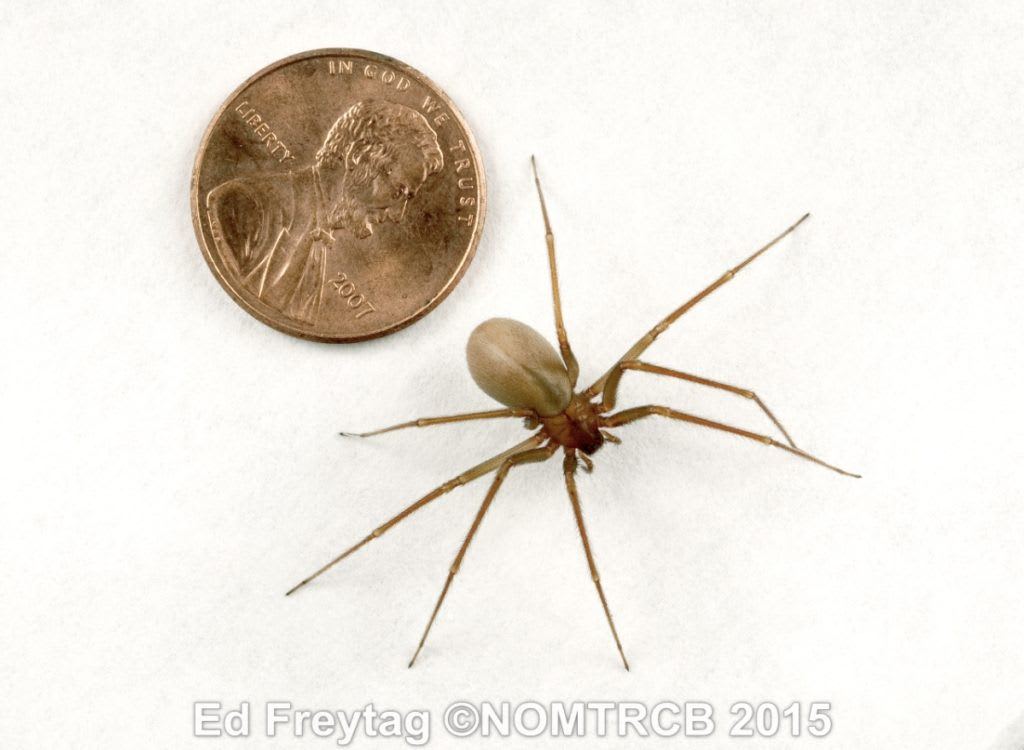
Brown Recluse Spiders Stay Hidden
The reclusive nature of a brown recluse spider seeks hiding places and shelter. Getting rid of Brown Recluse spiders will require understanding this reclusive behavior.
Brown recluse spiders are two venomous spiders in North America, the other being the Black Widow Spider that can inflict a dangerous bite.
Key Takeaway
While Brown Recluse Spiders are venomous, they are no more difficult to treat than other spiders.
You can protect you family and pets with regular inspections and treatments.
Brown Recluse Spider Control Steps
Get rid of Brown Recluse spiders by first eliminating their hiding areas' favorable conditions.
Inspect for brown recluse spiders and either vacuum them or spray them with a contact aerosol like CB 80 Aerosol.
We suggest using a residual insecticide as a perimeter spray such as Onslaught Fastcap, Suspend Poly Zone, Demand CS, Avesta CS, and Cyper WSP, to remove as many insects as possible that would enter your home and serve as food sources for these spiders. You can also spray this inside on baseboards, in corners, under furniture, and other areas where they are running. Just spraying these residual insecticides is not enough of treatment, however. It needs to be accompanied by inspection, cleaning, and dusting. We have a kit with Demand CS and PT 2llL in one kit called the Residential Spider Kit. Use the Demand CS outside (it may be sprayed inside as well), and the PT211L with its crack and crevice tip is used to spray into hiding places where the liquid can not reach.
It is important to inspect, clean, and exclude as much as possible and use a residual insecticide dust like Cimexa Dust or D-Fense Dust. Use Cimexa Dust or D-Fense Dust in all of their hiding places discussed below, such as wall voids, light switch plates, behind baseboards. These insecticide's dusts will stay in place six months to a year. Several handheld dusters can be used with an insecticide dust.
Besides spraying the perimeter, dust in voids, openings and cracks, and crevices found on the building's exterior. Dust any cracks and crevices with Cimexa Dust or D-Fense Dust before sealing the openings.
Read further spider control procedures outlined at Get Rid Of Spiders
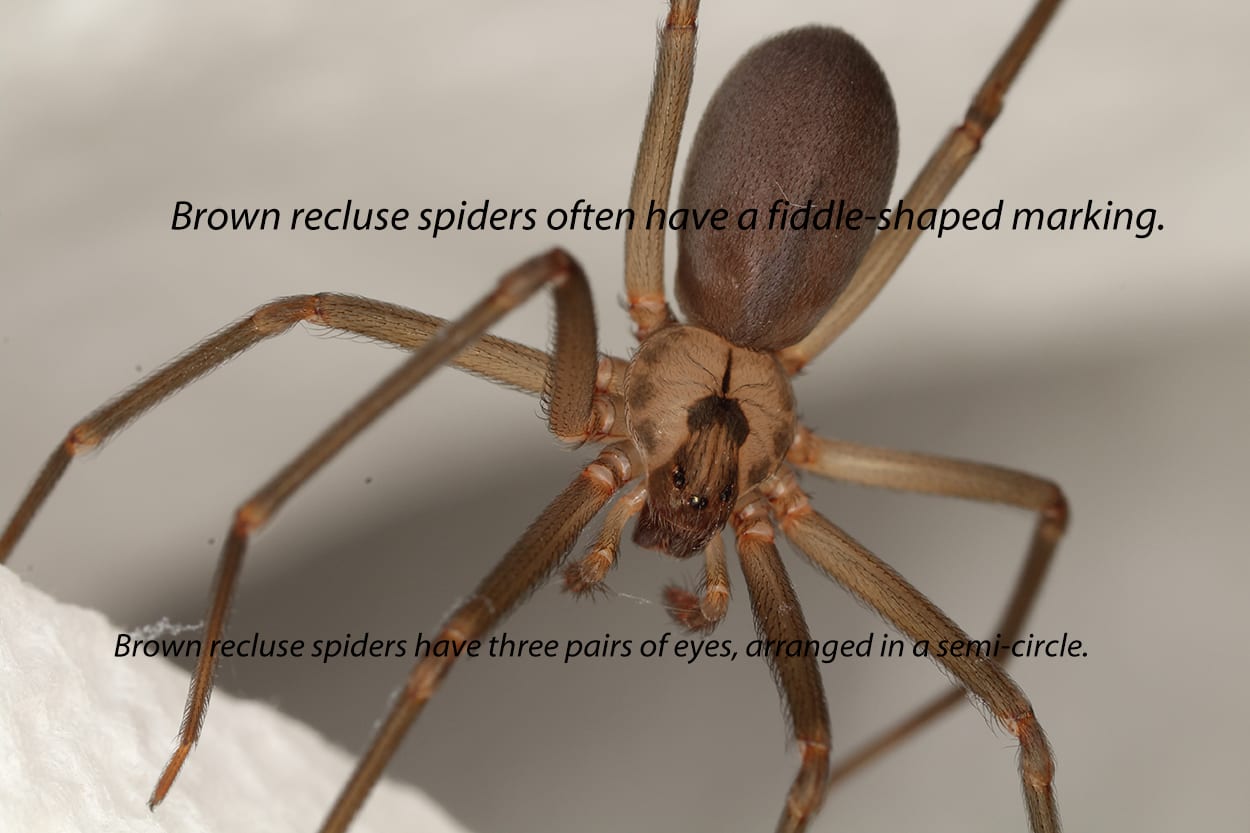
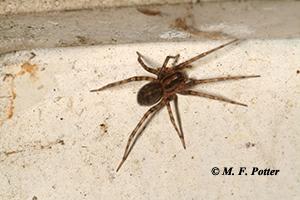
How to Identify a Brown Recluse Spider
- Brown recluse spider adults are soft-bodies, yellowish-tan to a dark brown, uniform color.
- 6 eyes; most spiders have 8 eyes
- Oval shaped abdomen
- The adult body varies from 1/3-to 1/2 inch in length. With the legs, it can be an overall size of 1-inch diameter or greater(Body not more than 1/2").
- No spines on legs with long thin legs that are uniformly colored.
- If the body is a different color than the legs or the legs have different colors, it is not a Brown Recluse spider. If there is more than one color on the abdomen, it is not a Brown Recluse
- Brown Recluse spiders have only fine hairs; if they have thick spines on their legs, they are not recluses.
- The brown recluse spider has a distinctive darker brown violin-shaped mark, with the neck of the violin pointing towards the abdomen.
- The tail end has no markings.
Monitoring with Spider Traps
Trapper LTD Insect Glue Boards will catch spiders and monitor the population. The Monterey Spider Trap will catch spiders and serve as a monitoring tool.
Brown Recluse Spider - Regions
Brown Recluse spiders can be found in the southern, western, and midwestern United States, especially Arkansas, Kansas, Illinois, Texas, Louisiana, Alabama, Kentucky, Mississippi, Oklahoma, and Missouri. Brown recluse spiders are very adaptable and may be active in temperatures ranging from 45 to 110 degrees F.
Brown Recluse spiders are also known as, fiddleback spiders violin spiders, and recluse spiders.
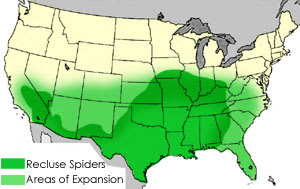
Brown Recluse Biology
The female lays eggs in off-white silken cases from May through August. They can lay 300 eggs in their lifetime. Spiderlings emerge in 24-36 days, leaving the egg case with slow development( 10-12 months), and are influenced by weather conditions and food availability.
They reach maturity in 10-12 months. These spiders can survive as long as two years without available food or water.
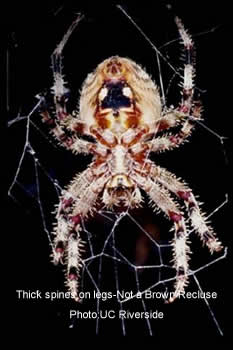
Inspection and Exclusion of Brown Recluse Spiders
- Make sure to wear long sleeves and gloves during the inspection.
- Always wear long sleeves, shirts, and gloves when you inspect for Brown Recluse Spiders. Since they stay in recessed and hidden areas, use a flashlight.
- They may be found in cluttered basements or closets. Brown recluse spiders are found in dark recesses, inhabiting stored clothing, old shoes, toys, books, boxes, furniture, stored linens, and undisturbed towels, sheds, etc.
- They can take shelter under furniture, appliances, carpets, behind baseboards and door facings, or in corners and crevices.
- Look for cobwebs, particularly around clutter, under insulation, inside wall voids. Their webs are irregular and loose and only used during the day for holding eggs. Their webs are hidden and used for retreats. It is made of silk spun in a recessed or hidden area, such as behind a mirror or wall void. They do not have their webs in open areas. The Brown Recluse is a hunting type of spider and not a web-hanging spider.
- They don't use webs for hunting and capturing food. These spiders wander at night and hunt for their prey. Their diet consists of other insects such as cockroaches and small insects. Many times, if you see a web hung on a ceiling, along walls, around shrubs, etc., they belong to another type of spider.
- Eliminate outside locations for brown recluse spiders:
- They may be found in storage houses or buildings where items are stored. Brown recluse spiders may be found in sheltered corners among the debris, woodpiles, piles of rocks, logs, debris, leaves, and under loose bark or stones.
- Inspect and clean inside locations for brown recluse spiders:
- They are usually found indoors, in bathrooms, bedrooms, closets, garages, basements, and cellars. Brown Recluse spiders may be found in forced hot air heating and air conditioning and often above-ceiling ductwork. They can be found harboring in or around the ductwork or registers.
- Seal cracks and crevices: As much as possible, seal openings, crack, and crevices in and around your home. Look for cracks and crevices in window sills, cables, wires, around pipes and door thresholds.
Brown Recluses - Avoidance Tips
- The brown recluse spider will only bite when disturbed in their secluded spot. This bite could occur under furniture or beds.
- It would be wise to shake out your clothing and shoes before dressing.
- Inspect items before using. If the brown recluse infestation is heavy, seal clothing items and shoes in plastic bags.
- Don't garden, handle firewood, pine straw, etc., without gloves.
- Try to keep doors and windows screened and shut.
- Minimize light from the outside. Lights attract insects, and the insects attract the spiders.
- Don't go barefoot.
- Remove beds from walls and curtains, keeping bedspreads and bed skirts from touching the floor.
- Lighten Up a room or let the sun into the house.
- Keep children and pets off of the floor, away from dark, cluttered areas.
- Inspect bedding before getting into bed.
- Eliminate as much clutter as possible in storage areas and frequently dust and vacuum around windows, corners of rooms, and under furniture.
- Dust and vacuum thoroughly to remove dead insects, spiders, webs, and egg sacs.
- Since brown recluse spiders stay hidden during the daytime hours in boxes, they can be easily transported in furniture and other stored items. Check these boxes.
Brown Recluse Spider Bites
People commonly get brown recluse spider bites in areas that the spiders had been hiding in shoes, stored towels, the old work shirt in the shed, etc. It is widespread to get a brown recluse spider bite when you are changing clothes, putting your hands into a pocket, or putting on shoes. The brown recluse spider had crawled in there at some time to take shelter. The Brown Recluse commonly bites when it is disturbed by being squeezed.
The initial pain with the brown recluse spider bites is not intense unless there is a severe reaction. Within 8 to 12 hours, the pain from the brown recluse spider bite becomes intense. Within 24 to 36 hours, the victim may have a fever, chills, nausea, joint pain, or restlessness. The brown recluse spider bite area enlarges and becomes inflamed, and the tissue is hard to touch. The venom of this spider has an enzyme that destroys cell membranes in the wounded area. The affected tissue sloughs away, exposing underlying tissues; over a few days, large ulcerous sore forms. An open wound from the brown recluse spider bite may range from the size of an adult's thumbnail to the span of a hand. The sore heals very slowly (6-8 weeks) and often leaves a large, disfiguring scar.
If Bitten by Brown Recluse Spiders:
- Collect the spider if possible for identification.
- Get medical attention immediately.
- Apply ice packs to relieve the swelling in the brown recluse spider bite area.
National Hotline Poison Center: 1-800-222-1222
Written by our resident pest control expert Ken Martin.




